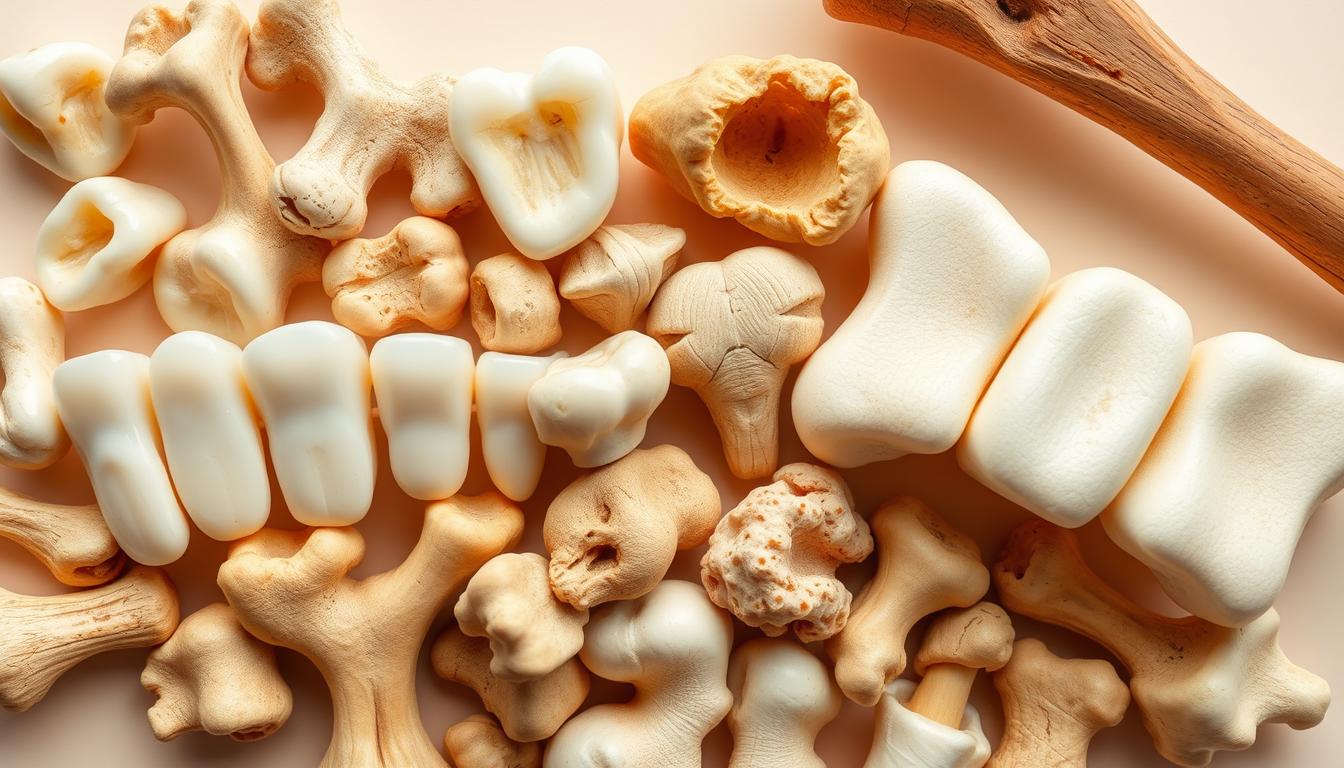As a parent, you might wonder about your child’s teeth and bones. It’s common to ask if teeth are bones. This guide will help you understand the link between teeth and bones. It will also clear up myths and teach you how to care for your child’s teeth.
Are Teeth Bones
Key Takeaways
- Teeth and bones have distinct structural and functional differences, despite some similarities.
- Understanding the developmental journey of teeth in children is crucial for maintaining optimal oral health.
- Proper nutrition, oral hygiene, and regular dental check-ups are essential for strong, healthy teeth.
- Recognising the signs of healthy tooth development can help parents identify any issues early on.
- Addressing dental emergencies and common problems promptly can prevent long-term complications.
Understanding the Basic Structure of Teeth vs Bones
Teeth and bones are different in many ways. We need to look at their basic makeup and how they are structured. They may seem similar at first, but they have their own special traits.
Composition and Mineral Content
Teeth are mostly made of calcium phosphate, which is very hard. This makes teeth strong and long-lasting. Bones, however, are a mix of collagen and hydroxyapatite, the same mineral as in teeth.
Structural Differences Between Teeth and Bones
Teeth have a hard outer layer called enamel. This protects the softer parts inside, like dentin and pulp. Bones, on the other hand, have a spongy inside and a hard outer layer called cortical bone.
Cell Types and Healing Properties
Teeth and bones have different cells and how they heal. Teeth have odontoblasts for dentin. Bones have osteoblasts and osteoclasts for building and breaking bone. Bones can heal, but teeth can’t.
In short, teeth and bones are not the same. They have different makeup, structure, and cells. Knowing these differences helps us keep our teeth and bones healthy.
The Journey of Tooth Development in Children
Understanding tooth development is key for every child’s growth. It starts with the first tooth and ends with a full set of teeth. Knowing the stages of children’s dental care helps keep their teeth healthy.
The first baby teeth appear around 6 months old. By 3 years old, children have a full set of 20 primary teeth. As they grow, their jaws expand, making room for permanent teeth.
At 6 or 7 years old, the first permanent molars come in. This is when permanent teeth start to grow. By early teens, most children have 32 permanent teeth, finishing their tooth development.
“Monitoring your child’s tooth development is essential for their overall dental health. Regular check-ups with a paediatric dentist can help ensure any issues are addressed early on.”
Parents are crucial in supporting their child’s tooth development. Good oral hygiene, a balanced diet, and regular dental visits are important. They help ensure healthy teeth growth.
Are Teeth Bones Guide Parents: Essential Facts and Myths
As parents, knowing the truth about our kids’ dental health is key. Many think teeth are like bones, but they’re not. Understanding the differences is important.
Common Misconceptions About Teeth
Many believe teeth are like bones, but they’re not. Here are some myths:
- Teeth are made of the same material as bones
- Teeth can heal and repair themselves like bones
- Teeth and bones have the same cell types and growth patterns
Scientific Evidence and Research
Research shows teeth and bones are different. Both have calcium and phosphorus, but teeth have enamel. Bones have different tissue.
What Parents Should Know
Knowing the difference between teeth and bones is key for kids’ dental health. This knowledge helps with oral care and dental issues. By staying up-to-date, parents can help their kids have healthy teeth for life.
“Educating parents about the unique nature of teeth is a vital step in promoting better oral health for children.”
Protecting Your Child’s Dental Health: Prevention Tips
As parents, we must focus on our children’s dental health. Regular dental care and good oral hygiene are key. Here are some tips to keep your child’s teeth strong and healthy.
Establish a Dental Care Routine
Introduce your child to daily dental care early. Teach them to brush their teeth twice a day. Use a soft-bristled toothbrush and fluoride toothpaste.
Start flossing when their teeth touch. This helps prevent cavities.
Limit Sugary and Acidic Foods
Too much sugar and acid harms teeth. Feed them fruits, veggies, and whole grains. Limit sweets, juices, and fizzy drinks.
Teach them to rinse with water after eating these foods. This helps protect their teeth.
Promote Fluoride Exposure
Fluoride strengthens teeth and prevents cavities. Use fluoridated water and fluoride toothpaste. Ask your dentist or paediatrician about fluoride supplements if needed.
Schedule Regular Dental Visits
Regular dental visits are crucial. Take your child to the dentist by their first birthday. Then, go every six months.
Following these tips will help your child’s dental health. It sets them up for a lifetime of healthy teeth.
“Investing in your child’s dental health today can pay dividends in their overall well-being for years to come.”
| Prevention Tip | Benefits |
|---|---|
| Establish a Dental Care Routine | Develops good oral hygiene habits, prevents cavities and gum disease |
| Limit Sugary and Acidic Foods | Reduces risk of tooth decay and erosion |
| Promote Fluoride Exposure | Strengthens tooth enamel and prevents cavities |
| Schedule Regular Dental Visits | Ensures early detection and treatment of dental issues |
Nutrition’s Role in Strong Teeth Development
As parents, we all want our children to have healthy, strong teeth. What they eat can greatly affect their tooth development. Knowing the right vitamins, minerals, and eating habits can help keep their teeth healthy.
Essential Vitamins and Minerals
Several nutrients are key for strong teeth. Calcium, phosphorus, and vitamin D help build and strengthen tooth enamel. Vitamin C keeps gums healthy and helps the body fix dental issues.
Foods That Strengthen Teeth
- Dairy products, such as milk, cheese, and yogurt, are excellent sources of calcium and phosphorus.
- Leafy greens, like spinach and kale, are rich in vitamins and minerals that support tooth and gum health.
- Crunchy fruits and vegetables, like apples, carrots, and celery, can help clean teeth and stimulate saliva production, which neutralizes acid and washes away food particles.
Dietary Habits to Avoid
Some foods harm dental health. Sugary and acidic foods, like candies, sodas, and juices, can damage tooth enamel and lead to cavities. It’s best to limit these and encourage water instead.
By choosing the right foods and avoiding harmful ones, you can help your child have strong teeth for life. A balanced diet is key for their dental health.
Establishing Proper Oral Hygiene Routines
As parents, it’s key to teach your kids good oral hygiene habits. This includes brushing, flossing, and using mouthwash. These steps help avoid cavities and gum disease, keeping your child healthy.
Brushing Basics
Brushing teeth is the first step in oral hygiene. Tell your kids to brush twice a day, morning and night, for two minutes each time. Show them how to brush gently in circles to clean all teeth surfaces.
Flossing for Healthy Gums
Flossing is vital but often forgotten. Start flossing when your child has teeth that touch. Move the floss gently between teeth, avoiding harsh movements that can hurt gums.
Mouthwash for Added Protection
At about six years old, introduce a fluoride mouthwash. Swish it for 30 seconds to kill bacteria and strengthen teeth.
Make oral care fun for your child. Let them pick their toothbrush and toothpaste. Use a timer or a song to make brushing a fun activity.
| Oral Hygiene Routine | Frequency | Duration |
|---|---|---|
| Brushing | Twice a day | 2 minutes |
| Flossing | Once a day | 1-2 minutes |
| Mouthwash (if appropriate) | Once a day | 30 seconds |
Stick to these routines and make oral care a daily habit. This will help your child have strong teeth and gums for life.
When to Start Dental Visits and What to Expect
Keeping your child’s teeth healthy is key for parents. Knowing when to take your child to the dentist and what to expect is important. This helps make dental visits positive and starts good oral hygiene habits early.
First Dental Check-up Timeline
Dentists say kids should see a dentist by their first birthday or when their first tooth comes in. This early visit lets the dentist check on your child’s teeth, spot any problems, and teach how to care for them.
Preparing Your Child for Dental Visits
To make dental visits good for your child, prepare them well. Here are some tips:
- Teach your child that the dentist helps keep their teeth healthy in a fun way.
- Read books about the dentist to get them used to the idea.
- Practice dental visits at home with a toothbrush or finger.
- Don’t say “hurt” or “pain” to avoid scaring them.
- Bring a favorite toy or blanket to make them feel safe.
By following these steps, you can make your child’s first dental visit a positive experience. This sets them up for a lifetime of good children’s dental care and parenting advice.
Managing Dental Emergencies and Common Issues
As a parent, it’s vital to know how to handle dental emergencies and common problems in kids. Issues like chipped teeth, cavities, and teething troubles need quick action. Knowing the right steps can help you care for your child’s teeth effectively.
Handling Dental Emergencies
If your child has a dental emergency, like a knocked-out tooth or a bad toothache, act fast. Start by cleaning the area with warm water. Then, use a cold compress to lessen swelling and pain.
Call your child’s dentist right away for an urgent visit. They’ll tell you what to do next.
Tackling Cavities and Tooth Decay
Cavities and tooth decay are common in kids. To stop them, keep up a good oral hygiene routine. This includes brushing, flossing, and using fluoride toothpaste regularly.
If a cavity appears, your child’s dentist might suggest a filling. This helps prevent further decay.
Navigating Teething Troubles
Teething can be tough for kids and parents. To ease your child’s pain, try gently rubbing their gums with a clean finger or a soft cloth. Chilled teething toys can also help, but check with your doctor before giving any pain meds.
Staying informed and getting professional advice is crucial for your child’s dental health. Work with your child’s dentist to keep their teeth and gums healthy.
“Proper dental care from an early age is essential for a lifetime of healthy teeth and gums.”
Signs of Healthy Tooth Development
As parents, knowing the signs of healthy tooth development is key. This helps spot any issues early and keeps your child’s teeth healthy.
Growth Milestones
Teething starts around 6 months, and by 3, kids have 20 primary teeth. Watch for these milestones:
- First tooth eruption around 6-12 months
- Complete set of 20 primary teeth by age 3
- Gradual loss of primary teeth, starting around age 6, to make way for permanent teeth
- Complete set of 32 permanent teeth by age 12-14
Warning Signs to Watch For
Every child develops differently, but some signs need attention:
- Delayed tooth eruption: If your child doesn’t have their first tooth by 12 months, see a pediatric dentist.
- Unusual tooth positioning: Crooked, crowded, or unevenly spaced teeth may need early help.
- Discoloured or pitted teeth: These could be signs of enamel defects or other dental issues.
- Persistent thumb-sucking or pacifier use: This can harm jaw and tooth development if not stopped.
By watching for these signs, you can keep your child’s teeth healthy and strong.
TO WATCH THE VIDEO CLICK HERE
Conclusion
In this guide, we’ve looked at the big difference between teeth and bones. We’ve shown that they are not the same. This helps parents understand why dental care is so important for their kids’ health.
Teeth and bones may seem similar, but they are not. Teeth need special care because of their unique structure. Parents have a big role in helping their kids’ teeth grow strong and healthy.
By following good oral hygiene and regular dental visits, parents can protect their kids’ teeth. This sets them up for a lifetime of happy, healthy smiles.
So, are teeth bones and children’s dental care are closely linked. With the right knowledge and action, parents can keep their kids’ teeth in top shape. This ensures their kids’ overall health is a top priority.
FAQ
Are teeth bones?
No, teeth are not bones. They share some minerals, but they’re different in structure and function. Teeth are hard tissues like enamel and dentin. Bones, on the other hand, are living tissues that support the body.
How does tooth development differ from bone development in children?
Teeth start forming before birth and come out in a set order. Bones grow and change all through childhood and teen years.
What are the key differences between the composition of teeth and bones?
Teeth have more minerals like calcium and phosphate. Bones have a mix of organic and inorganic materials. Teeth don’t have the living cells in bones for repair.
What are some common misconceptions about teeth being bones?
Some think teeth are bones because they’re hard. Others believe teeth can heal like bones. But, teeth and bones are different in the body.
How can parents ensure their child’s dental health and development?
Parents should teach good oral hygiene and eat a balanced diet. Regular dental visits are key. Watching for dental growth and fixing problems early helps keep teeth healthy.
TO EXPLORE MORE TOPICS CLICK HERE



